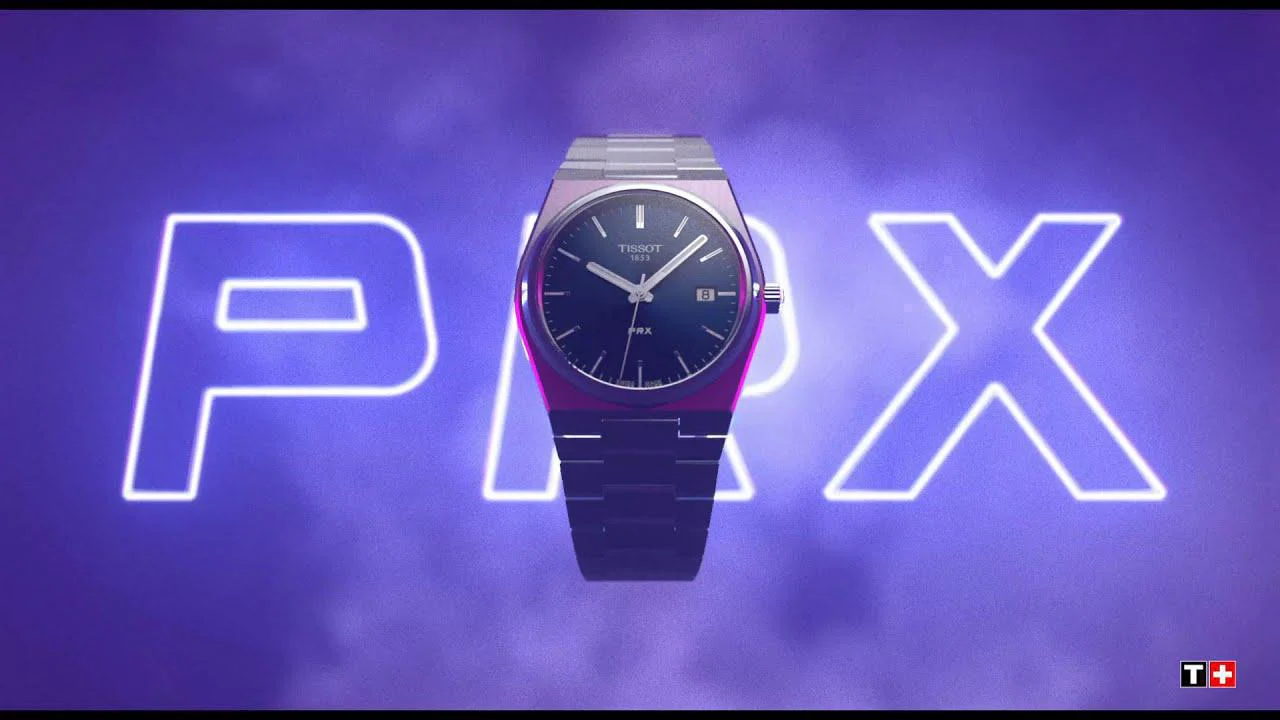









Tissot PRX
- Normal price
- $346.00
- Normal price
-
- Offer Price
- $346.00
- Unit price
- / by
Diameter
39.5 mm
Watch glass
Sapphire

Tissot PRX
- Normal price
- $346.00
- Normal price
-
- Offer Price
- $346.00
- Unit price
- / by
Insured shipping & free returns
A jeweler for 124 years
Info & specifications
Shipping & Returns





Discover the benefits of our unique shipping policy, optimized to make your shopping experience with us both efficient and highly satisfying:
- Free Shipping from €100: Benefit from free shipping for any order over €100. A smart way to get more at no extra cost - an instant savings!
- Insured Shipping: Peace of mind guaranteed with every purchase, thanks to our fully insured shipments. Your valuable selection is in safe hands, from our warehouse to your door.
- Efficient Delivery via UPS: We rely on UPS for their reliable and fast service, which means your orders are delivered quickly and safely. This is our commitment to excellence in customer service.
- Shipping Within 24 Hours: Your time is precious. That's why we ship in-stock items within 24 hours, so you don't have to wait long for what you want most.
- Exclusively Packaged: Each item is wrapped in elegant gift paper, making every order a special moment of joy. The perfect gift for yourself or a loved one with no extra effort.
- Track & Trace for All Orders: Stay fully informed with our instant track & trace information, so you know exactly when your carefully selected purchases will arrive.
This policy has been carefully crafted to match your expectations of quality, speed, and service. By choosing us, you are choosing a shopping experience that not only meets but exceeds your needs. Don't let this opportunity pass you by. Make your choice today and experience the benefits of shopping with confidence and convenience.
Discover the exceptional benefits of shopping with us, where authenticity and customer satisfaction are paramount:
- Official Dealer: As an authorized dealer of all brands in our range, we guarantee the authenticity and full manufacturer's warranty of every product. With us, you will find only the best, with the assurance that every purchase is genuine and directly backed by the manufacturer.
- Physical Stores in Rotterdam and Capelle a/d IJssel: Visit our stores in the bustling center of Rotterdam or the heart of Capelle aan den IJssel for a personal shopping experience. Our knowledgeable staff is ready to advise and assist you with your choice so you can confidently select the perfect product.
- New Products in Original Packaging: Every item in our range is brand new and comes in its original packaging. Complete with all accompanying accessories and instructions for use, exactly as the manufacturer intended.
- Activated Warranty at Purchase: Your peace of mind is important to us. That's why your product's warranty is activated on the day of purchase, protecting you immediately. Enjoy the security that comes with an official warranty, eliminating any concerns about quality or functionality.
When you store with us, you are investing in more than just a product. You are choosing a trusted partner who understands the value of true quality and customer service. With our official dealership status, physical presence, and commitment to new, authentic products, we offer a shopping experience that is both unique and reassuring.
Description
Tissot PRX - T1374101105100
The Tissot PRX - T1374101105100 is a timeless watch that offers the perfect balance of elegant style and robust functionality. Part of the iconic PRX collection, this model is a must-have for any watch lover looking for a sophisticated and reliable timepiece.
Design and Construction.
The watch has an impressive case size of 39.5 millimeters, making for a striking but not overly large presence on the wrist. The case is made of high-quality stainless steel, which not only provides a luxurious look, but also durability and comfort. The black dial adds a touch of elegance and makes the watch versatile enough for both formal and casual occasions.
Dial and Functions.
The Tissot PRX - T1374101105100 features a minimalist yet stylish dial. The black background is accented by silver-tone hands and indexes, which ensure excellent legibility. The watch is equipped with a date indicator at the 3 o'clock position, making it not only stylish but also practical.
Movement and Precision
The heart of the Tissot PRX is the Swiss quartz movement, known for its precision and reliability. This movement guarantees that you will always be on time without sacrificing style. The quartz technology ensures low maintenance costs and longevity.
Strap and Clasp
The stainless steel strap of the Tissot PRX - T1374101105100 is not only stylish but also comfortable to wear. The strap closes by means of a butterfly clasp with push-buttons, which ensures secure and easy attachment. This type of clasp adds to the overall luxurious look of the watch.
Water resistance
Another notable feature of this model is its water resistance to a depth of 100 meters (10 ATM). This means that the watch can withstand daily contact with water, such as hand washing, showering and even swimming, although diving is not recommended with this watch.
Conclusion
The Tissot PRX - T1374101105100 is a wonderful example of Swiss watchmaking. With its timeless design, robust construction and accurate quartz movement, this watch offers excellent value for money. Whether you're looking for a new addition to your watch collection or a stylish and reliable watch for everyday use, the Tissot PRX is a choice you won't regret.
Specifications
Product information
- EAN∶ 7611608298596
- Glass type∶ Sapphire
- Water resistance∶ 10 ATM/BAR: Swimming
Movement
- Functions∶ EOL
- Caliber∶ F06.115
- Clockwork∶ Swiss quartz movement
Watch case
- Case Width∶ 40 mm
- Case Diameter∶ 39.5 mm
- Weight∶ 13 g
- Case thickness∶ 1040 mm
- Case shape∶ Tonneau
- Case color∶ Silver
- Case material∶ Steel
Dial
- Dial color∶ Black
Watchband
- Bracelet material∶ Steel
- Closure type∶ interchangeable quick release bracelet, butterfly clasp with push buttons
History of the brand

Tissot
Founding year
Founding country
Owner
Production country
Amount of employees
Swiss Watches Since 1853
Founded in 1853 in Le Locle, Switzerland, by the father-son duo Charles-Felicien Tissot and Charles-Emile Tissot, Tissot began by manufacturing gold pocket watches. The brand quickly gained international fame, especially in Russia where their watches were popular at the Tsar's court. Tissot is known for its innovations in watchmaking; it introduced the first antimagnetic watch in 1930 and the first touchscreen watch in 1999. In 1930, Tissot merged with Omega, resulting in the formation of the Pre-Swatch Group SSIH, a move that strengthened their position in the watch market. Today, Tissot is part of the Swatch Group and is the official timekeeper of many sporting events.
This rich history highlights Tissot's enduring legacy as a pioneer in watch design and technological innovation, which has earned the brand a respected position in the watchmaking world.
The collection

Tissot PRX - 01 January 1978
The Tissot PRX collection embodies the essence of modern elegance and timeless design. With its streamlined aesthetic and refined details, the PRX exudes subtle yet powerful style.
This range of watches effortlessly combines sporty appeal with chic allure, making it suitable for both formal occasions and everyday use. The iconic design of the PRX watches includes an integrated bracelet and slim case, creating a seamless and harmonious look.
Beneath the elegant exterior lies reliable craftsmanship, with features such as high-quality materials and Swiss Made precision timepieces. The Tissot PRX is not only a timekeeper, but also a symbol of sophistication and versatility, seamlessly blending form and function.
Whether for a formal event or an informal gathering, the Tissot PRX collection offers a stylish companion that reflects time in a timeless and contemporary way.
Shipping tailored to Your Needs:
With us, your convenience comes first. That's why we guarantee that every order is shipped insured by UPS, so you can shop with peace of mind. Place your order before 4 p.m. on a weekday? Then we will ship it the same day. Orders after 4 p.m. will be shipped the next business day. Please note that UPS does not deliver on weekends, so we work together to get your purchases to you as quickly as possible.
Flexible Return Policy:
Not completely satisfied with your purchase? No problem. You have 30 days to return your product. Return costs are only €2,95. Would you like to exchange for another size or another product? We'll do that for you for free. And if you choose a gift certificate instead of a refund, we'll cover the return cost. For more details, visit our returns portal.
Why shop with us?
- Security: Your purchases are insured; your satisfaction comes first.
- Speed: Fast shipping means less waiting and more enjoyment.
- Flexibility: Our return policy gives you the freedom to choose what works best for you.
- Economical: Choose a gift card and we'll cover your return costs.
Discover the perfect blend of convenience, speed and security with us. Your satisfaction is our driving force, and we strive to make your shopping experience as pleasant as possible.
Stock
On back order
In stock: shipped within 24 hours.
Reorders: we will inform you about the delivery time, average delivery time 2 weeks.
Out of stock: currently not available.